Text
This week, I will be talking about two movies which represent interracial couples – be it romantic or friendship couples.


Loving, directed by Jeff Nichols, came out in 2016. It tells the true story of how interracial couples obtained the right to be married in the United States of America.
Mildred is black and Richard in white. They got married in the state of Washington where it was legal for them to do so and came back to the state of Virginia where they lived, but where it was illegal for them to be married as an interracial couple. They immediatly got arrested and were legally obliged to leave the state of Virginia and not to come back for twenty years. For ten years, they fought the state of Virginia in a case called « Loving VS Virginia ». In 1967, the Supreme Court declared the Loving Family as the winners and allowed all couples – without distinctions – to be married in the USA.
Green Book is a friendship story between an white man and a black man. The story takes place in New York in 1962, during the end of segregation. Tony Lip, a white man, is hired to be Dr Don Shirley’s driver. As the movie shows us, Tony and his family are racist which makes him driving a black man across the South of the US – the most racist part of the US – a bit peculiar.
Both movies show us a couple going « against » the expectations of the world they live in. The Lovings aren’t supposed to be together, even their own families don’t understand and feel they’re putting themselves at risk needlessly or playing a character. Richard is told by a white cop he must be the fruit of incest therefore « stupid » and so that is the only reason he would be with a black woman. On the other side, some of his black friends call him a fool for marrying a black woman as a white man because he is inflicting the hard life of a black man upon himself instead of choosing the « simple » life he could have had as the white man he is. They tell him black men don’t have this choice and have to face a hard life.
The Lovings seem to have everyone against them, it is touching and remarquable to see how their love still prevails.
In Green Book, Dr Don Shirley has a powerful scene where he explains to Tony that he isn’t accepted by the black community and we can see throughout the movie that he isn’t accepted by the white community – he can play piano for them but isn’t allowed to eat dinner in the same room as them, for example.
Both movies have characters that aren’t accepted in their own communities or the other community because they are going against society’s expectations. Because of this, the main characters of both movies seem to be cut off from society.
They are physically cut off in the scenes they play in: the Lovings live in a secluded house at the end of a very long road and Tony and Dr Don spend the movie in a car. Both couples are in their own little bubble which seems to be the only way to stop the outside comments, to be true to themselves and to be able to grow.
Green Book shows Tony Lip’s growth : he goes from being a very racist man to accepting and respecting Dr Don Shirly and welcoming him into his family. It is important to note that this movie received bad critics for using the « white savior » trope because Tony Lip saves Dr Don Shirley on many occasions: be it from the black or the white community.
Both movies are based on true stories and showed archival images at the end. Green Book’s scenario was written with the recordings of the real Don Shirley and the letters of the real Tony Lip. It gives a stronger aspect to the movie to know the scenes we see come from true experiences.


The scenes in Loving where the couple is being professionaly photographed in their home is based on true events and we can see the actual pictures at the end of the movie. The Loving’s remaining daughter was on the set of the movie to make sure the story was told as it happened and says she was shocked at how similar the actors were with her parents.
Both movies carry the spirit of these stories and seem to be an incredible hommage that the actual families were pleased with.
Both movies join together as they show how the couples change ‘some’ people’s minds through the love and respect they have for one another. They show a significant evolution and are a true testament to how humans are the same, be it black or white.
Laure Fletcher
0 notes
Text
Quinzaine 55 : show these films that we cannot see ! 4/4
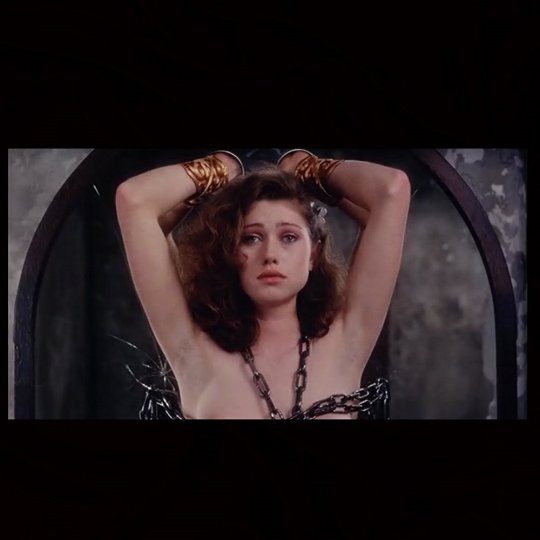
La Quinzaine will have other great surprises in store for us, such as the Franco-Japanese co-production of Fruits de la passion by Shuji Terayama in 1981, a very free adaptation of Retour à Roissy by Pauline Réage. The even freer adaptation in 1986 of the Devil with a body by Marco Bellocchio and its real fellatio which will cost Maruschka's career dearly. The dreamlike, the lyrical, the diaphanous Kissed, the first film by Lynne Stopkewich, a necrophiliac fable taken from a short story by Barbara Gowdy. And the very contemporary Leap Year by Michael Rowe exploring the mechanics of a sadomasochistic couple.
Then other forgotten films: The Girl Offered by Helma Sanders-Brahms, Irezumi – Tattoo Spirit by Yoichi Takabayashi, The Cold Esquimaude by Janos Xantus, Annabelle Partagée by Francesca Comencini…

So many films around one and the same subject, an ancestral problem that seems to rule the world: sex. Political sex, social sex, spiritual sex, sexes, sexualities. Sometimes represented with modesty, sometimes with exuberance, sex is honored in these works which have been able to magnify it with respect.
Sexuality, even over-represented, is still taboo. A small part of each of us sleeps in a shell of ice. The role of these films is, among other things, to melt this armor so that the spectator discovers with emotion another facet of his personality, beautiful, pure, and luminous.
La Quinzaine is the receptacle of sensuality from all over the world. She delivers a haven of cottony warmth to one of the biggest cinematographic institutions. She does not deny what makes up an entire part of Man, she embraces it, she appropriates it, with a program that is always precise and surprising. La Quinzaine reinvents sex on the big screen and gives it credibility.
- Clara Sebastiao
3 notes
·
View notes
Text
Quinzaine 55: show these films that we cannot see! 3/4
“1973, we banned. 1974, we liberalize. Before repressing in 1975
then punishing in 1976” (Between two censures, 1989, Tony Crawley
and François Jouffa) On April 28, 1974, Valéry Giscard d'Estaing, newly elected President of the Republic, announced the abolition of censorship in France and advocated freedom of expression and creation. This decision will revolutionize the entire cinematographic landscape. In the capital, in the suburbs and in the provinces, cinemas shamelessly display erotic works on their facades and in
their halls. In one year, more than 128 voluptuous films were released in theaters: Les Jouisseuses, Emmanuelle, and La Papesse (to name but a few) set the crowds ablaze, rushing to see the taboo in scope. This slight curiosity will push 6,497,687 Parisians and suburbanites to cloister themselves in the confined, overheated and electrified rooms of the operators of 74. The Secretary of State, Michel Guy, in a burst of lucidity, or in a moment of weakness, will even authorize exploitation of pornographic films!

This wind of freedom will quickly reach the Croisette which will present to its official selection the sulphurous One Thousand and One Nights by Pier Paolo Pasolini and the outrageous Nine Lives of Fritz the Cat by Robert Taylor. La Quinzaine, for its part, will look to Yugoslavia to find THE right director for this year full of buttocks: Dusan Makavejev, author and screenwriter of Sweet Movie.
Carole Laure (Miss Canada) files a complaint against Makavejev, Anna Prucnal (Anna Planeta) is exiled from Poland for seven years, the film is banned in Great Britain and, in France, it is banned for minors under 18 . All this for what ? For a film-manifesto, a strong work which despite itself has generated a bigger scandal than it envisaged. For an erotico-political poem where socialism and capitalism contemplate each other with a curious eye and seek to tame each other. Unlike Dusan Makavejev's other films, Sweet Movie offers us a more direct social confrontation, without indigestible
government soliloquies. He seeks here to establish a sensory screen-spectator relationship. Sensuality is the main guideline of the staging
and the script, all the cohesion of the film crew aims to advocate the joy of living, universal love and self-knowledge through sex. Makavejev drops the masks of self-censorship, the spectator is exposed, his shell splits and melts in the face of Sweet Movie's warm humor and sexual sweat. We speak here of a "therapeutic effect" as a "light aphrodisiac", a non-verbal communication pushing the public to observe, feel, touch, taste and discover themselves through the work. Let us underline the fact that Makavajev, feeling guilty for this overflow of happiness in the face of the misery of the world, inserted into the film documentary sequences on the excavation of Polish corpses by Nazi officers.
Sad cruel world.
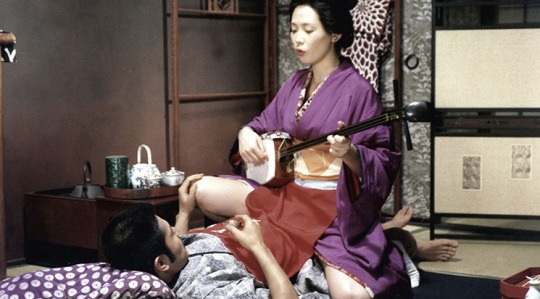
We will end the year, on October 17, 1974, with the abolition of the support fund for porn films… Are Monsieur Giscard and Monsieur Guy going back on their convictions? In 1976, the good resolutions of our two friends were shelved. Pornography? Eroticism you say? The past. Law X imposes itself insidiously, feigning the absence of censorship and displaying a simple restriction. The VAT on so-called porn films goes from 17.6% to 33.33%, 161 films are classified X
and prohibited from exploitation… The few works still in circulation are relegated to specialized cinemas penalized fiscally and financially. If that isn't censorship…
But the Fortnight still and always resists restriction, isolation, and blame, and it shows it more than ever with The Empire of the Senses by Nagisa Oshima. All of France is shaken, the phenomenon is unprecedented. Moreover, L'Empire des sens is not drowned in the selection, far from it, it is the opening film of this new program, the work brought to light, the work under the spotlights of the public, of critics, journalists, and the organization.
We will not expand more than necessary on this film which has already caused a lot of ink to flow (and many other more natural liqueurs). Just remember that this is a snub to Japanese taboos. Nagisa Oshima procured virgin French film, impregnated it in his native land, and sent him back to France for birth. L'Empire des sens is banned in Japan, Germany, Sweden, the United States, Belgium… But the Fortnight takes up the challenge of presenting this work, and tries to open the public's gaze not to an erotic film or pornographic, but on a visual poem worthy of Japanese prints. Everything here is implacably meticulous, the staging is refined, the dialogues finely orchestrated, and the dazzling colors reinforce the lyricism of what was originally just a news item.
L’Empire des sens establishes one and the same discourse: that of a
continuous love scene, the frame changes but the act remains. Even if the sex is not simulated, even if the final scene is incredibly violent, the film remains immaculate thanks to its visual perfection, and thanks to this speech being neither more nor less than an approval of the life unto death, the ultimate and unconditional love.
The works seen above are political, social, rebellious. She uses the
representation of sex to convey more or less abstract messages, but they neglect the love encountered in the sexual relationship. Nagisa Oshima, him, the sublime.
But if you miss politics, remember that in 1988, interviewed by Bernard Pivot, Jacques Chirac confessed: “I saw L’Empire des sens in the hall of a private cinema which belongs to the Ministry of Information. I felt it was a very beautiful film…”
Thanks to the Ministry of Information and thanks to Jacques!
- Clara Sebastiao
0 notes
Text
Chantal Akerman, Jeanne Dielman and the 68's feminist movement
In 1968, student and feminist demands began to shake paternalistic societies in Western Europe and the United States. Women's movements developed, with discussion groups and street demonstrations. Women demanded their right to speak out in the face of male-dominated student groups, which often forgot about them in their meetings and demands. They campaigned for their rights to equality between men and women and against the structures of patriarchal societies that subjugated them and locked them into roles (housewives, good wives, etc.). The women's movement, its ideas and theories, also spread to film-making and the arts, where issues of the female gaze and voice were discussed, as well as the invention of new cinematographic forms to counter the dominant male visions that confine women to audiovisual representations. Laura Mulvey's text Visual Pleasure and Narrative Cinema came out in 1973 and was one of the first calls for an alternative cinema that "transcends worn-out and oppressive forms, and dares to defy the normal conventions of cinematic pleasure in order to conceive a new language for desire". In their productions, the women filmmakers of this feminist avant-garde had to destroy the satisfaction and pleasures of dominant cinema in order to write a new history of women's place in cinema and society. In 1978, in an article for the German feminist journal "Frauen und Film" , of which Helke Sander was editor-in-chief, she declared that the new women film-makers had to become aware of their own oppression and the past oppression of the women who had gone before them. These contemporary filmmakers must begin to see themselves, others and society through their own eyes, with their own cinematic visions. They must break with the dominant patriarchal cinematographic forms to create new forms, content and techniques. The result will be different social conditions for women. These new cinematic visions will be able to transform society profoundly, or at least make it think differently. Chantal Akerman, who began making films in 1968 with her first short Saute ma ville, was strongly influenced by the women's movement and its reflections on cinema. The movement encouraged her to stay in film production, to make it her profession, as she declared in an interview with Cahiers du Cinéma in 1977: "(…) And there was the women's movement, and it was largely because of that that I stayed. And little by little, but very slowly, it dawned on me that cinema was becoming a profession for me, in other words that this was what I wanted to do: get myself produced and no longer work to the right or to the left, in whatever I wanted." The female rights movement is therefore an influence on her work, a driving force behind her creation. It is undeniable that this has influenced Jeanne Dielman's subject and the very form of the film.
The form of the film is indeed innovative. In 3 hours 40 minutes we see the daily life of a housewife unfold, down to the smallest detail. In her article "Death in installments ", Jayne Loader describes the aesthetics of the film as follows: "(…) Jeanne Dielman examines three days in the life of her heroine, each day consuming approximately one hour of screen space. Much of the action of the film is shot in "real time. If it takes Jeanne fifteen minutes to peel a batch of potatoes, then the fifteen minutes are presented on the screen without a cut. Yet the moments thus shown are of necessity carefully selected; three days must be compacted into three hours, rather than 72. Much of the film and, for me, its strongest sections are about housework." It is indeed unprecedented in cinema to see a story about a housewife whose gestures and their meticulous repetition are the heart of the film. Feminist critics are unanimous in saying that Akerman has invented a form that has never been seen before in cinema, and is profoundly different from the preoccupations of films made by men. Housework is not usually shown in films, or at least not for as long. Yet everyone has seen their mother or wife bend over in some way to do the dishes, as Chantal Akerman points out in an interview with "Frauen und Film". But these images are so commonplace that they have become part of our common unconscious. The fact that these daily tasks, which are more often reserved for women, are shown in their entirety is a way of making them visible to viewers, of denaturalising them in a film that shows the performative nature of these tasks, their archetypal character, in an "ultra-realistic" style.

Léonie Pessey-Magnifique
0 notes
Text
The paintings in Kurosawa’s Dreams : paintings in the cinema part 4/4
It was inevitable to write about this movie when we consider the relationship between paintings and cinema. In Dreams, Akira Kurosawa plays and experiments with several cinematographic methods and special effects that make this movie a true masterpiece. In fact, George Lucas and Steven Spielberg were collaborators for the movie since it’s a co-production from the United States and Japan. In this film the director stages eight different dreams that are all tied together by themes of environment, nature, childhood and spirituality[1].
In the third dream called “Crows”, Kurosawa tell us a story about a man who seems to be an art student or an aspiring artist who gets transported to the paintings of Vincent Van Gogh as if it was in a dream. Here, thanks to George Lucas assistance, the paintings become the stage of the character where he tries to find Van Gogh. In this sequence, this man goes through numerous paintings of Van Gogh that, thanks to the work and effort of Kurosawa and his team, are replicated with an unbelievable authenticity.
As Kurosawa once dreamt about being a painter, this sequence is a direct reference to his past and his old dreams. Kurosawa abandoned his dream about becoming a painter to become a filmmaker. Nevertheless, Kurosawa maintained his artistic skills and for this movie, as for many others, he hand-painted the storyboard.
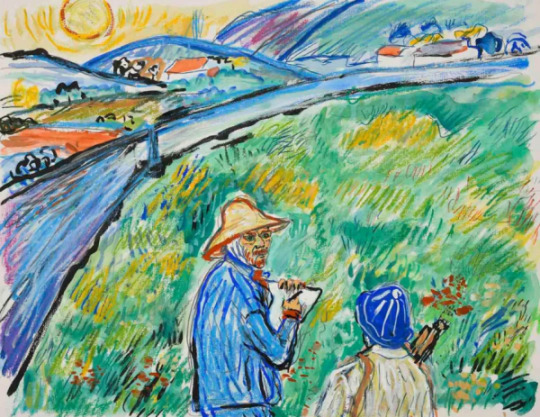
Hand-painted storyboard by Akira Kurosawa
In this sequence, the character that embodies Kurosawa meets Vincent Van Gogh in one of his paintings. Van Gogh was a very important figure for Kurosawa and this vignette is a clear homage to Van Gogh’s paintings. In “Crows” Kurosawa took very seriously the colours of Van Gogh’s artwork and he recaptured them as vivid as they are on canvas. This attempt of making living paintings by replicating some of the most famous paintings of Van Gogh is very successful as the scenes caught immediately your attention by their undeniable beauty.

Hand-painted storyboard by Akira Kurosawa
Nogami was in charge of the production of the film and ensured that the replicas were as close to the real paintings as possible. He says that to replicate the painting of “Langlois Bridge at Arles” they dyed the river with blue painting to obtain the same shade as the one in Van Gogh’s painting[2]. This is how much Kurosawa was determined in reproducing with an undeniable accuracy the work one of his favourite painter. He even asked Martin Scorsese to play Van Gogh, Scorsese being one of the most iconic filmmakers in the United States at the time. If as it wasn’t enough, with the stunning living paintings and Scorsese, Kurosawa adds to this sequence the “Raindrop” prelude of Chopin, one of Chopin’s most famous work. “Crows” is in this way a commemoration of Van Gogh’s, Chopin’s, Scorsese’s and Glance’s work. This last one is referenced through a metaphor of Van Gogh’s work as a locomotive, as a reference to Glance’s movie “La Roue”.
Laura Cárdenas.
[1] Lee Thomas-Mason, “Akira Kurosawa's spectacular hand-painted storyboards” in Far Out Magaizne, 14th Oct 2021 : https://faroutmagazine.co.uk/akira-kurosawa-hand-painted-storyboards/
[2] Simon Jenner, “A Sabukaru Introduction To Akira Kurosawa’s 'Dreams'”, Sabukaru, : https://sabukaru.online/articles/the-prescience-of-memory-in-akira-kurosawas-dreams
0 notes
Text
Jean-Noël Picq gives a voice to The Garden of Earthly Delights of Hieronymus Bosch : paintings in the cinema part 3/4

In 1980, Jean Eustache made a short-film about The Garden of Earthly Delights of Bosch. This triptych is considered one of the most enigmatic paintings of Bosch and is considered a masterpiece until today. This painting has been studied by many artists, scholars and intellectuals. The composition drawn by Bosch between 1490 and 1510 is rich in symbolism and has provoked numerous debates between art historians. Eustache chose to Jean Noël Picq to analyze it in front of three amateurs and the camera. The staging gives an atmosphere of a small gathering between friends. Jean Noël Picq, who is a psychoanalyst, gives a very intimate interpretation of this painting without showing it to his audience while sitting on a red chair and smoking a cigarette.The painting is only entirely shown in the middle of the short-film, so 15 minutes after Jean Noël has already started his analysis. This choice of Jean Eustache gives us a unique experience since at first we only witness Picq talking about a famous painting and making references to specific parts of the painting. However the camera makes a close-up of these details but does not show the entire painting right away.
Jean Noël Picq makes his own interpretation through the symbolism carried by the objects and the animals painted by Bosch. Even if Picq’s analysis is very subjective, the viewer, if he or she is sensible to this painting, is carried away very easily. Although you might not agree with Jean Noël Picq in every comment that he makes, it is an interesting experience to assist such an intimate scene. It feels like we are entering Jean Noël’s minds when he looks at the painting for the first time. Eustache gives us the rare sensation that Picq is giving us access to all the thoughts that are coming to his mind as he admires the painting in front of us.
Throughout the whole film the sexual reference call the attention of the viewer. This could be linked to the fact that the painting of Bosch has a lot of sexual representations between humans that are half animals or even between objects, or humans and objects. Nevertheless, the staging chosen by Eustache is also very sexual. There are two women listening to Picq, apparently hypnotized by the speech given by Picq. In fact, the speech of Jean Noël Picq concentrates mostly in the third painting of the triptych with represents “the last judgment”.
Eustache has already experienced with this form of filmmaking with “A dirty story” which is a film also featuring Picq where he tells a dirty story to a group, mostly to a group of women. Eustache actually filmed this movie twice with different actors. Moreover, Eustache uses his traditional long monologue as he does in other movies like The mother and the whore.
This short film, even if it enters numerous clichés that are recurrent of Eustache’s filmmaking and of the 1980s, is a very interesting perspective to introduce paintings into cinema.
Laura Cárdenas.
0 notes
Text
“The Feminine Ideal” : paintings in the cinema part 2/4
If in the last article, Kate, one of the main characters of Dressed to kill identifies herself with the portrait of Alex Katz, in this article I would like to write about a character that embodies a portrait. In many movies like Titanic by James Cameronor Renoir by Gilles Bourdos, painters make portraits of nude women who model for them. This practice is as old as the history of paintings and its staging in movies is also a common practice when it comes to films about painters or artists. Nevertheless, I would like to write about a painter that made a portrait about a girl that he never saw. The portrait The Feminine Ideal by Maxence, the poet-paintor soldier in Jack Demy’s film The Young girls of Rochefort, is one of the main characters of this musical comedy about finding love. This portrait of an unknown women is incarnated by Catherine Deneuve as Delphine Garnier.
In Dressed to kill the women is confronted to the painting and the act of observing provokes mixed feelings for her. In The Young girls of Rochefort, Delphine is puzzled by the resemblance between her and the women in a painting exposed at her ex-boyfriend’s gallery. Her ex-boyfriend Guillaume thinks that this portrait is not about Delphine because for him it’s a figurative painting and Delphine is more than that, she is a spiritual being. For Guillaume this is a pure imaginative artwork without any significant value. However, the resemblance is undeniable.
Maxence, the painter, is searching for this women all over the world but his quest seems to be unreachable and pointless. For Maxence, an abstract painter that made his first and only figurative painting, this woman exists purely in his imagination. Although he’s convinced that she can exist in real life. In Maxence's head, this woman already has a name, a voice and a face. This imaginary woman has golden hair, an innocent glance, a silhouette that resembles to “mythical creatures that haunt museums and adolescents” and a way of walking that reminds him of some childhood memories. This imaginary women, this “ideal” its purely an intellectual model, an artificial being who seems unreachable.

The Feminine Ideal reverses the relationship between the painter and the muse and between the figurative painting and reality. Here the pictorial imaginary precedes the reality[1]. For Josephine Jibokji Frizon, the portrait made by Maxence imitates Bernard Buffet’s style characterised by portraits without any smiles and disembodied silhouettes. For Maurice Druon, Bernard Buffet is an artist haunted by the need to impose his vision of the outside world[2]. This corresponds exactly to what Maxence is doing with his painting of an ideal woman. Throughout the whole movie we think that this ideal model is Delphine but actually the only real resemblance is a physical one. In fact, Delphine claims to be something more than an objet. She says to Guillaume that he considers her as a doll and he neglects her way of thinking, her feelings. She doesn’t even understand why Guillaume loves her since, in her opinion, he doesn’t really know her. We could say that Maxence, as an idealist, is also reducing this “feminine ideal” to that, an idea, and Delphine or any women is more than an idea, more than an objet, they are complex human beings.
What is beautiful about this movie and the choices of Jacques Demy is that the meeting between Maxence and Delphine is never shown in the movie. We can understand this as an invitation to value ideals and dreams in art but also to acknowledge that what’s important is the path and not the ideal itself. The Young Girls of Rochefort is a beautiful film even if the characters only meet at the very end of the movie.
Laura Cárdenas.
[1] Joséphine Jibokji Frizon, “La peinture en fiction. Expériences artistiques et amoureuses dans la galerie de peinture des Demoiselles de Rochefort”, 2015, p.100
[2] Ibid
0 notes
Text
Soviet union films that you should check out
Viy (Вий) (1967)
The film was directed by ukranian directors Konstantin Yerchov and Georgi Kropachyov in 1967. The film is an adaptation of Nikolai Gogol's short story Viy, published in 1835. The story is about an encounter between three young men freshly out of the seminary in Kiev and a witch, to whom they take shelter after wandering off into the plain. The witch sets her sights on one of them, Thomas, who is not fooled and tries to catch her at her own game. In revenge, she pretends to be dead, and Thomas is forced to watch over her body in a chapel for three days. After what, Thomas’ soul is promised to heaven. But things don't go according to plan, and the corpse comes back to life at night, to torment the young clerk.

Gogol's story is rooted in the rich folklore of Ukraine, but from the outset it is an anti-clerical manifesto. This vein can be felt in the film adaptation, which sticks very closely to the text. Indeed, anti-clericalism was one of the main spearheads of the Soviet regime, which meant that the adaptation project was widely welcomed by the authorities. What is interesting, however, is that the film delves into Ukrainian cultural history and gives a fantastic portrait of medieval Ukraine. One can see this especially in the duel between Christianity and older local beliefs, and particularly through the character of the witch as she invokes the demon Viy, king of the gnomes, as Thomas is trying to perform exorcism on her.
The film is on the side of horror, but paradoxically it is less through the evocation of monsters than through the character of the witch herself. The power of Natalya Varley's gaze is heightened by the stillness of the shots and the silence, building up the film's horrific tension. The ambivalence of this character, who oscillates between looking like a young girl and an old woman, tends to deconstruct the vulnerability of female characters in cinema. It is she who triumphs in the story, simply by virtue of her powers, which enable her to destroy the man who was standing up to her. In relation to the context of the film's production, this character is truly unsettling just as magnetic.

The character of the young clerk is also very interesting. Far from being a hero, he has many flaws, including alcoholism and cowardice. The use of diy special effects with proto-green screen attempts to make the character's flaws more palpable on screen. He is very much inspired by the characters of Gothic novels, and his destiny only confirms this.
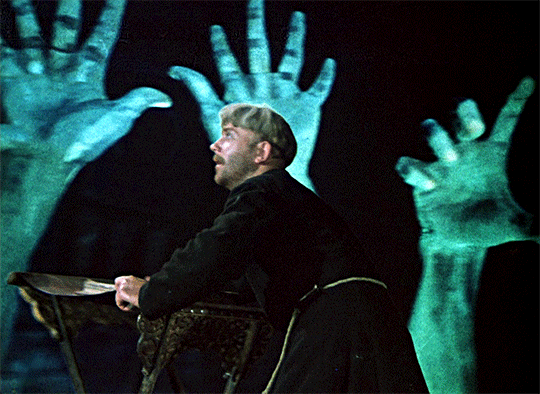
As for the figure of the devil Viy, it encapsulates both the power of folklore and the fatality that mows down in its path all individuals who do harm to society. It is Thomas's greedy and selfish quest for salvation that causes his downfall. Beyond these considerations, the staging of the demonic saraband is remarkable. Many of the special effects, such as the green screens mentioned above, and the analogue processes used in the sets and costumes are brilliantly executed. And in a way, they set the standard for the representation of monsters in cinema, since relatively similar processes will be found in other films later on, such as Peter Jackson's Lord of the Rings saga (2001-2003).

Link to watch the film : https://youtu.be/4YmQn6q36HQ
J.A Lenourichel
6 notes
·
View notes
Text
Similar stories of girls in uniform: 4. Overview of lesbian representation in boarding school movies

In the previous articles, we saw multiple innovative movies about the representation of lesbians through boarding school films. This type of movies was one of the first tolerated ways to depict lesbianism on screens because the relationship between two women was not always explicit and the scriptwriters could play on the confusion with a strong admiration for a role model or even with a substitute mother. However, we saw that some of these films were still rather explicit about their subject, but it came with a problematic vision of romantic relationships: a teacher taking advantage of her position to seduce under-age girls.
Over time, it has become a little more common to present lesbian stories in cinema, even if it is still quite rare. While the types of stories have diversified, some rather recent releases continue to pay tribute to the boarding school film genre. The 2006 release Loving Annabelle, directed by Katherine Brooks, re-adapt the entire story of Olivia and Young girls in uniform, but make the story incredibly explicit as the teacher and the student end up sleeping together, and the teacher being condemned by the law for it. Another movie and surely a better one, Lost and Delirious, released in 2001 and directed by Léa Pool, finally presents a vision of love between two students. Answering to the codes of the teen movie genre, it is a bit surprising that it took so many years to have the story focusing on the relationship of two female boarders. But considering the difficulties of the time, like the code Hays that firstly made the Children’s Hour story heterosexual, these movies were still a first step towards the representation of lesbians in cinema.
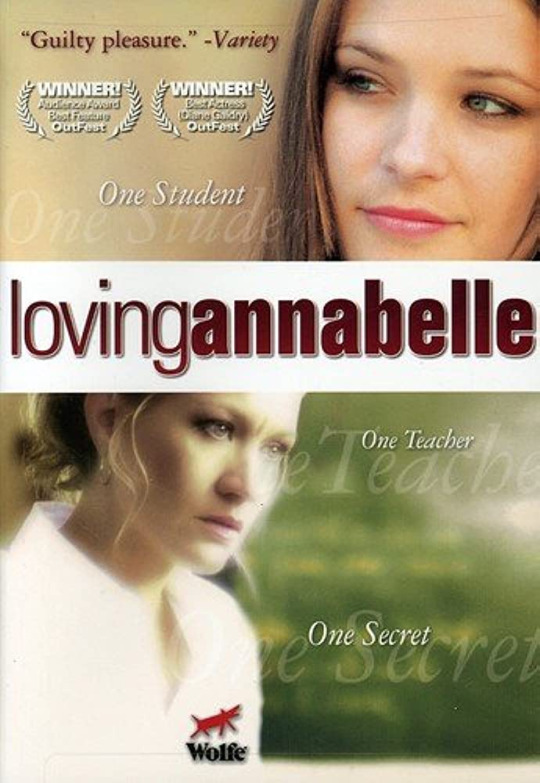

There was a time when one of the only ways to cross paths with Sapphic stories was through autobiographical inspired literature, written by female authors, and many movies came from their adaptations. We talked about Gestern und heute by Christa Winsloe in 1930, and about Olivia by Dorothy Bussy in 1949, but it is funny to observe that it is more common than what it first appears. Another example is French literary superstar Colette, who expresses all her feelings as a young teenager in Claudine in 1900, including her joy at spending time at her school with "Mademoiselle Aimée", whose name simply means "Miss loved".
If the boarding school movies were important to develop the representation of lesbians in cinema, we can now demand beautiful and ethical stories about Sapphic romances, and ones that don’t even solve with the death of one of the protagonists! We can however still be grateful for their existence at a time where they were essential: for example, Mädchen in uniform, released in 1931, became cult in the LGBT community. We can also feel the need to know and to preserve that history of queerness in cinema with the recent restorations of Olivia and Mädchen in uniforms. It is thanks to that work of preservation of the past that we can build the cinema of tomorrow.
Zoé Richard
4 notes
·
View notes
Text
Beyond video : the sprawling multimedia universe of On Cinema

Many shows on the internet seemed to have a similar evolution during the 2010’s. Due to the lack of resources and the DIY nature of the content produced, many shows adhered to simple premises and were very formulaically driven in order to build and keep a faithful audience as well as being easier to produce for something tedious by nature. Then, they often evolved step by step, by including narrative elements, ending up as full blown universes and stories. On Cinema is not merely one of them, it is the epitome and masterpiece that characterizes this process and takes it to its full extent.
Being the brainchild of American comedians Tim Heidecker and Gregg Turkington, two writers known respectively for their absurdist and satirical humor, the show is, at first, thought of as a parody of movie critic shows, like Siskel & Hebert’s one. Though the twist is that both characters have the most bland and irrelevant opinions about movies. Spreading across 13 seasons, many specials and an actual humongous multimedia universe that often meddles with real life itself (most characters being themselves fictional versions of their actors), let’s see how On Cinema got where it is now.
(My goal is not to guide you through the whole thing, a Vulture article already exist for that ttps://www.vulture.com/article/tim-heidecker-and-gregg-turkington-on-cinema-guide.html, but I want to show you the extent of the show and the process of its evolution).
First things first, let’s deal with the formula. The show actually started as a very short podcast setting some elements of what was about to come, like the movie being rated in bags of popcorn and the bland analysis. But the core of the show is the 10mins formula, in video, with both characters on each side of the screen sitting in chairs, and up to a ¾ of the show taking place in movie theaters. Tim is characterized by his overwhelming white middle aged man aura, prone to anger issues and always butchering the names he reads on his notes due to some kind of dyslexia. While Gregg is the “movie buff”, owner of a large VHS collection, unconditional fan of the Hobbit and having the unsettling power of ignoring everything that’s going on around him only to deliver the most boring anecdotes and completely off track and far-fetched analysis on movies. The humor is painstakingly slow burning, hence you really get the show after having watched plenty of episodes and let the characters slowly creep into your brain with their quirks. The show functions very ritualistically, you find yourself waiting for things to happen or looking for the small variations (for instance the sentence Tim will say in the opening). And it also settles its own ritual specials, being On Cinema, the show’s main specials are dedicated to faint broadcasts of the Oscars while also setting narrative elements regarding the show. In the On Cinema community it became a real Oscars counter-party.
All the while, an array of characters develops unseemingly, you get to meet Doctor Sanchez, Joe Estevez (fictionalized), Mark Protsch (fictionalized) and many others, and get glimpses of stories infiltrating the movie reviews. It’s scary how good the show is at extending its universe with the most minute details and through the most weirdly compelling formats. And those eventually blur the lines between the level of depth in which the different product of the shows lies. For instance, there is a show called DECKER, whose showrunner is fictionalized Tim Heidecker, but which is of course available like a standalone show on youtube. I mean you could come across it and take it at face value as you would an episode of On Cinema. There is a coherence throughout all of this though, based on the characterizations of fictionalized Tim & Gregg. DECKER is, in our a reality, a spoof of espionage franchises, while in the reality of the On Cinema universe it is a serious espionage show that echoes all of Tim’s traits, his conservative views and patriotism, his lack of skills and unwillingness to learn, his pettiness, etc. The Trial of Tim Heidecker is the special that really started to turn things around though. It is a 4 hours, semi-realistic trial of Tim. It is as slow burn as the rest, but also uses the trial setting to string many elements from the show together. Tim ends up winning in a trumpesque fashion and plots a revenge on the district attorney of San Bernardino. This gives place to a mockumentary called Mister America, in which he campaigns in the street for this fake election. At every turn they blur the line with reality, for instance they both use their regular Twitter account to tweet in character sometimes. Or there is also the fact that both Gregg and Tim played in (bad) superhero movies so they could review it and have petty quarrels in their show about it. And the list could go on and on.
It seems almost impossible to talk about this monstrosity in a comprehensive manner so I must stop myself here. In order to conclude, I’d say that On Cinema, as an all encompassing artistic project that relies on the anti-spectacular to do its wonders is therefore a remarkable tribute to the possibilities the internet has to offer in terms of audiovisual creation. Not only does it satirizes subtly a part of the American society, mostly its conservative side. It’s also a actual criticism of the dullness of the cinema industry through the choice of the movies they review. While still being a love letter to audiovisual art in general and exploring in a prolific manner many ways a fictional universe can engage viewers and creators alike in a very concrete and real manner.
So if you’re looking for a rabbit hole to fall in, by all means go and check On Cinema At The Cinema :
youtube
William Renard
1 note
·
View note
Text
Love is not in the air. Tchaikovsky's wife by Serebrennikov

For the last article of this series of Serebrennikov movies and how his work can be related to the dissident movement; we are going to take a look through his last movie : Tchaikovsky’s wife.
This movie came out in December of 2022, during an unstable period in Russia torn between the war in Ukraine, the backlash of a majority of countries because of their decision in the war and with some of the laws against human rights. We could think that a story of one of the most famous musicians of the country would be a great nationalist movie but no, this story is well chosen to show how poorly Russia has evolved. Serebrennikov said it himself : “It is absolutely impossible for my film to be shown in Russia".
But before talking about this subject, let’s get back to the movie itself. As described in the title, Tchaikovsky’s wife is a story, with some fictional liberties, about the wife of one of the greatest music composers (in my humble opinion) and how she dealt with the fact that she was abandoned by him because of his homosexuality. The main role is played by Alyona Mikhailova and the composer is played by Odin Lund Biron. Tchaikovsky’s wife during her whole life refused to believe that her husband was not interested in women, and it drove her in a state of delirium and craziness. There's something disturbing, because everybody is a victim in this movie. Tchaikovsky is not understood but does nothing to help her wife; and his wife is not letting go of her husband and becomes a conceited character. Because of this situation, she ends up in an asylum where she died in 1917. Serebrennikov tried to understand both the two personalities by reading their letters : almost every sentence in this film is taken from her memoirs. We can applaud the way Serebrennikov decided to shoot the scene of the movie : because the two characters are lost in their relationship, the whole movie is kind of dark, and the angles of the camera are here to remind us that we are looking into somebody's life. During the whole movie, we can see some whispering, some strange looks from the other characters : those scenes are exaggerated with some beautiful plan-sequence shots. The fact that he comes from theater is shown in this movie, and this is what makes the beauty of it. I really enjoyed how he portrayed the insanity of Tchaikovsky’s wife with the use of theatrical methods. This movie reminded me of this famous play from the summer of 2022, The Black Monk that he presented for the first time in Avignon.

The way Serebrennikov made this movie is interesting to analyze. Because of his problems with the Russian government in the past, and because he wanted to talk about homosexuality in a non-LGBTQ+ friendly country, his movie had to go through a lot of steps to be made. At first and for a few years, he couldn’t even start shooting the movie, because nobody would finance his movie. In today’s Russia, because of the propaganda against homosexuality, there’s no way this movie can be shown. And the worst fact with this movie is the fact that being homosexual in the 19th century seems easier than nowadays. The birth of the movie is also interesting, because the parallel with today's Russia was not at first the goal of the movie. Since his childhood, Serebrennikov was passionate about Tchaikovsky's work and life. He read everything about him, up to his letters with his wife. But, he never could quite identify his mysterious character. With everything going on in Russia, he decided to take the point of view of his wife, to emphasize what’s going on.
The thing that is interesting with this movie is that the critiques of it are the best. Most of the critics say that the movie is up to the standards of the other movies of Serebrennikov BUT it’s a must see because of how the director manages to criticize today’s Russia politics.
Milana Tsakaiev
1 note
·
View note
Text
The post-soviet madness from Petrov's point of view (Part 3/4)
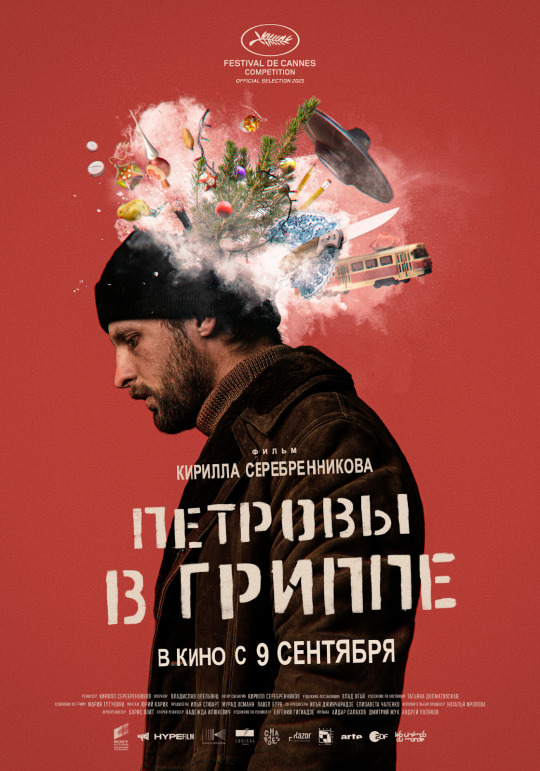
The first scene of the movie: Petrov is in the middle of a public execution. This is how Serebrennikov starts the movie which is the topic of this article, a drama of a destroyed country after a long running dictatorship.

This movie is very interesting to analyze because it portrays the deepest wrongs in post Soviet Union society: unemployment and misery. This is a portrait of the actual destroyed Russia, a tired Russia, where people are living without helping each other and they are all suffering from bad government decisions. Life is so hard that the only solution for the main character is to get lost in his memories, even if they are fake sometimes. And in a way, the way Serebrennikov describes his country can only be true because of its brutality: he shows us crime, misogyny, racism and political violence. In this movie we actually can see a lot of the similarity between the Soviet Union with his hard reforms and the actual situation with Putin’s political choices. The memories of Petrov’s and his actual state doesn’t show us a big change.
Since Serebrennikov first appearance in the movie industry, his film was presented for the first time in Europe in the 2021 Cannes Film Festival for the Palme d’Or (and it won the Vulcan Award for cinematography). His movie became a sort of symbol for freedom of speech because he kept making them while being under house arrest - as we saw previously. This can be seen in the help of Serebrennikov with the productions from France, Switzerland, Germany and the United States. As he says himself:
“[Petrov’s Flu] came at a rather difficult time in my life. Like an outlet, an essential joy, even a lifeline”.
0 notes
Text
Underground soviet rock and punk : Serebrennikov's Leto (Part 2/4)

To start this journey around Serebrennikov work and his dedication in this new wave of the dissident movement let’s look into his movie Leto.
Leto, which means summer in Russian, is a movie that came out in December of 2018 which stars Roman Bilyk, Irini Starshenbaum and Yoo Teo. It’s a beautiful movie in black and white that describes the situation in the Soviet Union during the late 80s. During this period, the country was going through the perestroika, which is a time when people could only listen to Occident music, and especially rock and punk music, underground. Those types of music, such as Lou Reed and David Bowie were exchanged in those underground networks. Some major groups emerged during this time. Leto describes the foundation of one of the most famous Russian rock groups, Kino with Viktor Tsoï. The movie is about this group but also the way they change the rock’n’roll industry in the Soviet Union. To do so, the whole movie is in black and white, there’s even the use of fake archive footage, and metaphoric characters as the punk or the septical, to show the story of rock. Kirill Serebrennikov wanted to do a film that has an echo of the situation in Russia in 2018:
“Leto is a rock’n’roll story, during a hostile climate for rock music and occidental influences. Our story is based on the necessary faith to pass through this context and the recklessness of our heroes for the restrictions”.

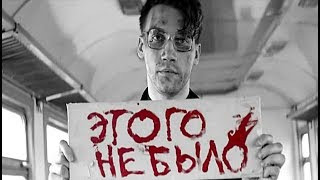
0 notes
Text
The New Wave of the Russian dissident movement : the story of Kirill Serebrennikov (Part 1/4)

Kirill Serebrennikov hadn’t seen his homeland since the start of the war between Russia and Ukraine for personal beliefs. He’s a very talented and diverse artist, from the theater scene to the movie industry, but since Putin's dictatorship, his life depends on the warm welcoming of European countries, especially Germany and France.
Kirill Serebrennikov was born in Rostov-on-Don on the 7th of September 1969. He’s been a film director and theater designer since early 2001 when he staged his first production in Moscow which is the start of his career, making his way to the infamous Bolshoi Theater. Since then, his theater work was recognized everywhere in the world. He’s also a movie maker, with three award-winning movies : Leto (2018), Petrov’s Flu (2021) and Tchaikosky’s Wife (2022).
Serebrennikov is also known to be one of the many voices for freedom of speech and human rights in Russia during Putin’s presidency. We can say that he’s one of the faces of a new wave of dissident movement. A dissident “is a person who actively challenges an established political or religious system, doctrine, belief, policy or institution”. This term was founded during the 18th century but was primarily used to talk about writers and artists that criticized the authority of the communist party during the Soviet Union. Most of the time those artists either published their art in an underground system or they had to flee their country in order to publish their writings. Since Putin is at the head of the Russian government, a lot of Russian artists have to do the exact same thing, and one of the examples is Serebrennikov.
In 2012, he became the artistic director of The Gogol Center in Moscow, where he undertook the renovation of the place as the center of liberal arts : he invited a lot of Russian artists to promote their political and critical work through art. From there he spoke against the 2014 Russian annexation of Crimea and showed as well his support for Russia’s LGBT community. But many people from the conservative Russian government saw in his actions a danger to the safety of the government. In 2017, he was arrested because of alleged embezzlement, which led to a trial where he was convicted with a debt and three years of probation. He was also banned from leading any cultural institution and was fired from the Gogol Theater. In 2022, the government closed the theater, like many other places that are fighting for human rights, because of their position against the War in Ukraine. The fact that he is a part of the LGBT community, his position against the Russian government and the struggles to continue his work led him to flee the country.
Since then, he has continued his work from Europe. During the summer of 2022, he presented at the Avignon Festival his theater piece : The Black Monk, a short story by Anton Chekhov (Serebrennikov is the first Russian artist to present his piece in Avignon since 1994!). This play was the perfect moment for Serebrennikov to speak about the recent event and our conception of liberty. During the final act, he decided to add a message on the big wall “STOP WAR”.
For the next articles, we will follow Serebrennikov’s film production starting with Leto, then Petrov’s Flu and ending with Tchaikovsky’s Wife. The context of production of those movies show in different ways the willingness of the artist to fight against the Russian government. We will see, with those three movies, this new wave of dissident movement in the history of Russian cinema.
1 note
·
View note
Text
Le Fond de l'air est rouge, Chris Marker

Le Fond de l’air est rouge is a film about the struggles between the mid-1960s and 1977. It is composed of two parts preceded by a prologue. The first part is entitled “Les Mains fragiles” and the second part is entitled “Les Mains coupées”, these two parts are themselves subdivided into two sections. This three-hour documentary, in its final version, is a montage of archival images from various sources. There are images of television news, militant films and even images of fiction feature films. These archives come from all over the world and require the viewer to have some knowledge of the political movements of the sixties to be fully understood. Indeed, the images are not explained didactically, it is their relationship that generates meaning.
Le Fond de l’air est rouge tells history through associations of images creating imaginary points of contact between social movements taking place in various places. These places are brought together by their visual resonances rather than by their logical links (cause and effect, common context, etc.).
In this film, Marker wanted, whenever possible, to bring the document closer to the conditions of its creation. Thus, the people who filmed the events that make up the film are invited to comment on their images to reveal their meaning. The second hour of the first part entitled «Mai 68 et tout ça» begins with the following sentence « Pourquoi – quelques fois – les images – se mettent-elles – à trembler ? ». Chris Marker testifies « Moi, ça m’est arrivé en mai 68, boulevard Saint-Michel... » and Davos Hanich « Moi, à Prague, l’été 68… Quand j’ai vu les rushes, j’ai vu le tremblement. J’avais maîtrisé mes mains, mais la caméra avait tout capté. »
For Marker, the cameraman does not have enough perspective on his images at the time of their shooting. He is unable to measure their historical significance. But when, a few years later, these images are confronted with other more recent images or from another country, they reveal all their power of meaning. For example, in the first part of the film, the Spanish writer, screenwriter and politician Jorge Semprun comments on the events of May 68 : « les rues de Paris se sont mises à ressembler à celles de toutes les grandes villes d’Europe et d’Amérique en l’an 68 ». This rapprochement makes it possible to imagine that May 68 takes place in a context of huge revolts. This gives the images of Paris a greater meaning.
Clara Réthoré
0 notes
Text
Le Joli Mai, Chris Marker et Pierre Lhomme

In the aftermath of the Algerian War, Chris Marker directed Le Joli Mai. In this documentary, he goes through the streets of Paris and talks with the inhabitants about their daily life, their desires and their fears. The filmmaker digs deeper into the question of community by creating a real collection of exchanges, conversations, things lived together. He interviews Parisians of all ages and social classes by asking them questions on topics as varied as democracy, racism or even happiness. Producer Catherine Winter writes: “Le Joli Mai will be a ricochet film, the authors will only be question throwers, on the water of Paris: we will see how the stones will fall, and if they go far”. This documentary is therefore both a dialogue film but also a film that provokes dialogue.
In appearance, the filmmaker shares with us the thought of others but it is more truly his that this film puts forward. Thus, even if the interviewees spoke freely in front of the camera, they answered the questions previously selected by the director evoking the themes of which he himself wanted to speak.
Le Joli Mai provided valuable documents on his contemporaries while being an aesthetic work. Chris Marker’s subjectivity and artistic talent is particularly expressed through editing. The critic Laetitia Mikles explains: “He assembles his sequences according to the model of the game of Kyrias. Unique and diverse characters follow one another. They don’t know each other but the filmmaker finds them a common point, a detail to articulate the scene of one with that of the other”. Through this process, the filmmaker emphasizes the complementarity of human beings. It also highlights social disparities within the same community. Thus, scenes illustrating the precariousness of the working classes are followed by scenes in the middle of the Paris Bourse. In another sequence, Marker uses the montage to ridicule two engineers a little too condescending. Thus, he interrupts them with videos of grumpy cats.
To conclude, Le Joli Mai is a precious archive of Parisian thought in 1963. However, it is primarily Chris Maker's point of view that is expressed.
Clara Réthoré
0 notes
Text
All that Tunisian cinema has to offer
Tunisian cinema was a forerunner. It offered the world its originality thanks to the genius of its filmmakers (e.g. Nacer Khémir) and its contribution to cinematographic production (e.g. the JCC). Tunisian cinema was born in a particularly fertile soil, that of cinephilia and admiration for the great works of the 7th art worldwide, and it's thanks to him that I've opened up to this art. Also Film clubs and the JCC helped to shape both filmmakers and a demanding public, of which I think I am the product.
From the outset, there was no question of aligning with the 'old' Arab cinema in existence (Egyptian commercial cinema), Tunisian cinema wanted to stand out from the melodramas and the musical films from which a few 'auteurs' were struggling to emerge. For the majority of Tunisian filmmakers, it was more a question of succeeding, each according to his or her own style, with original “expression” films (political, social, cultural, etc.) bearing the stamp of their director and aiming for the artistic quality already achieved at a world level.

This freedom of choice has been helped by the fact that Tunisia also doesn’t have film censorship (different from television censorship) which is undoubtedly one of the most flexible in the Arab world: scenes that are banned in other Arab countries like the celebration of female nudity (Halfaouine (1990)), homosexuality (L’Homme de cendre (1986)), political repression (Sabot en Or (1988)), sex tourism (Bezness (1992)), women's right to sexual fulfilment (Fatma (2001), Satin rouge (2002)) were finally accepted by Tunisian censors as long as they were expressed by artists and were necessary to the coherence of their work.

The miracle started with L'Homme de cendres (1986), unlike most countries of the South where arthouse films remain confined to the ghettos of arthouse cinemas or are exclusively destined for the 'prestige' of foreign festivals, Tunisian audiences gave national films an unprecedented triumph, (shattering by far all previous audience records for Hollywood or Egyptian films), even for "difficult" films such as Chich Khan (1991). Thus Tunisian cinema invented a new cinematographic category, that of "mass auteur films" ! Today, this type of cinema continues to shine, with films such as Enhebek, Ya Hedi (2016) and Ashkal (2022). These movies continue to delight a broad local audience while retaining their 'auteur' touch. Kaouther Ben Hania's next film, Les filles d'Ofla (2023), which was a hit at Cannes, also promises to be a mass success despite its offbeat subject and direction.
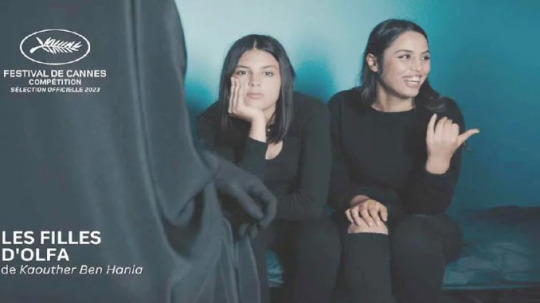
However, today, even if Tunisian cinema continues in its tradition to amaze, it is losing its stature because of politics and economic decisions. After the revolution, cinema was destabilised just like the rest of the country.
The Ministry of Culture now only funds three films a year and almost always turns its back on single-screen cinemas. Many of them are now turning to foreign institutional support, which is deplorable because it encourages neo-colonialism.

What's more, the cinema I always went to (Ciné Jamil) had to close its doors last year, despite having tried to obtain state subsidies. Meanwhile, a Pathé multiplex has opened in the country's two biggest cities. When I heard the news, my heart broke and the Tunisian cinema that had nurtured so many dreams is now in perdition.Today, a much more globalist, capitalist and neo-colonialist policy is taking hold, whereas for years Tunisia had managed to resist it.
In the meantime, all we can do is hope for an economic reorganisation and the awakening of a "young new wave" that will shake up the country's politics and ensure the success of tomorrow's Tunisian cinema.
Maya Labiadh
0 notes